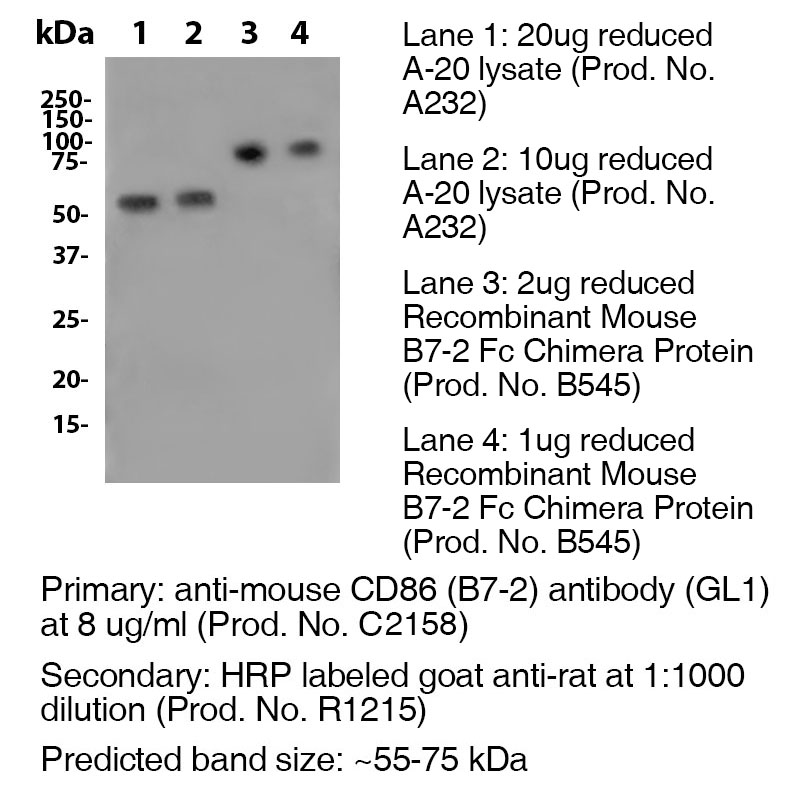Anti-Mouse CD86 (Clone GL1) – Purified in vivo GOLD™ Functional Grade
Anti-Mouse CD86 (Clone GL1) – Purified in vivo GOLD™ Functional Grade
Product No.: C2158
- -
- -
Clone GL1 Target B7-2 Formats AvailableView All Product Type Monoclonal Antibody Alternate Names B7-2, B70, Ly-58, CD-86 Isotype Rat IgG2a κ Applications B , ELISA , IHC FF , in vivo , IP , WB |
Data
- -
- -
Antibody DetailsProduct DetailsReactive Species Mouse Host Species Rat Recommended Isotype Controls Recommended Isotype Controls Recommended Dilution Buffer Immunogen LPS-activated CBA/Ca mouse splenic B cells Product Concentration ≥ 5.0 mg/ml Endotoxin Level < 1.0 EU/mg as determined by the LAL method Purity ≥95% monomer by analytical SEC ⋅ >95% by SDS Page Formulation This monoclonal antibody is aseptically packaged and formulated in 0.01 M phosphate buffered saline (150 mM NaCl) PBS pH 7.2 - 7.4 with no carrier protein, potassium, calcium or preservatives added. Due to inherent biochemical properties of antibodies, certain products may be prone to precipitation over time. Precipitation may be removed by aseptic centrifugation and/or filtration. Product Preparation Functional grade preclinical antibodies are manufactured in an animal free facility using in vitro cell culture techniques and are purified by a multi-step process including the use of protein A or G to assure extremely low levels of endotoxins, leachable protein A or aggregates. Storage and Handling Functional grade preclinical antibodies may be stored sterile as received at 2-8°C for up to one month. For longer term storage, aseptically aliquot in working volumes without diluting and store at ≤ -70°C. Avoid Repeated Freeze Thaw Cycles. Country of Origin USA Shipping Next Day 2-8°C RRIDAB_2749827 Each investigator should determine their own optimal working dilution for specific applications. See directions on lot specific datasheets, as information may periodically change. DescriptionDescriptionSpecificity Clone GL-1 recognizes an epitope on mouse CD86. Background CD86 is an 80kD Ig superfamily member that is involved in immunoglobulin class-switching and activation of NK cell-mediated cytotoxicity. CD80 is closely related to, and works in tandem with CD86 to prime T- cells. CD86 is expressed earlier in the immune response than CD80. The ligation of CD28 on T cells with CD80 and CD86 on APCs co-stimulates T cells resulting in enhanced cell activation, proliferation, and cytokine production. CD86 can also bind to CTLA-4 to deliver an inhibitory signal to T cells. Antigen Distribution CD86 is expressed on activated B and T cells, macrophages, dendritic cells, and astrocytes. Ligand/Receptor CD28, CD152 (CTLA-4) Function T cell costimulation, Ig class-switching, NK cell cytotoxicity PubMed NCBI Gene Bank ID UniProt.org Research Area Cell Biology . Costimulatory Molecules . Immunology . Neuroscience . Neuroscience Cell Markers References & Citations1. Hathcock, K.S. et al.. (1993) Science 262(5135:905-7 2.) Gubin, M. et al. (2018) Cell. 175(4):1014–1030.e19 Journal Link Technical ProtocolsCertificate of Analysis |
Related Products
- -
- -
Prod No. | Description |
|---|---|
S211 | |
R1364 | |
I-1177 | |
C247 | |
F1175 | |
R1214 | |
S571 |
Formats Available
- -
- -
Prod No. | Description |
|---|---|
C2168 | |
C2163 | |
C2164 | |
C2165 | |
C2166 | |
C2167 | |
C2159 | |
C2160 | |
C2161 | |
C2162 | |
C2158 | |
C2050 | |
C6158 | |
B585 |



